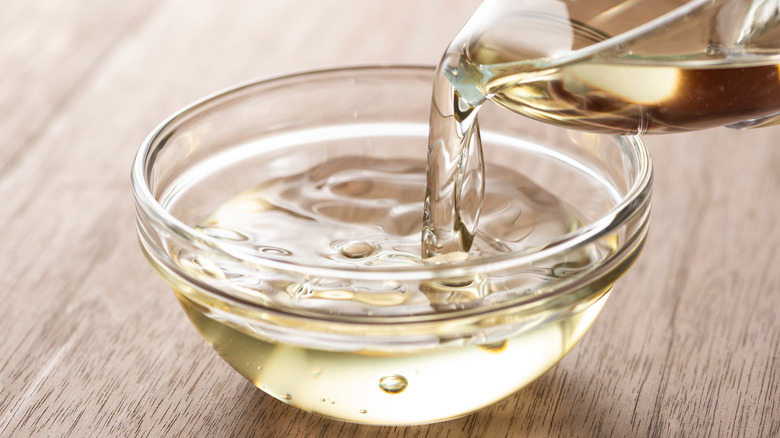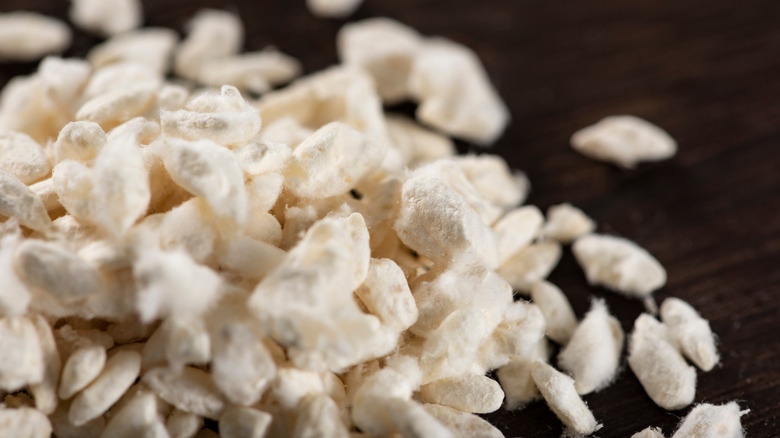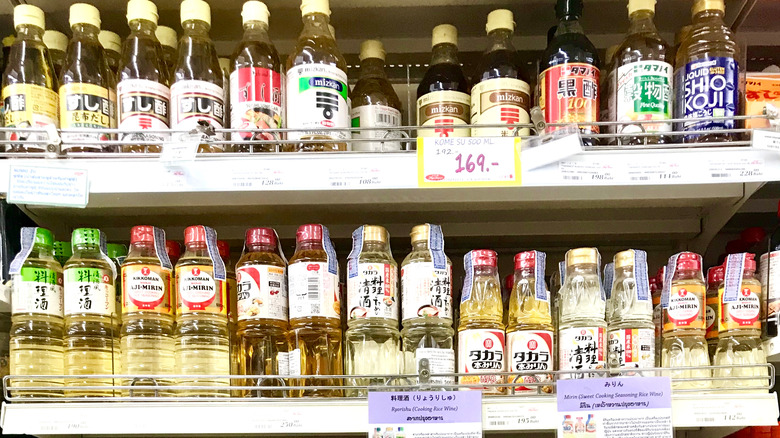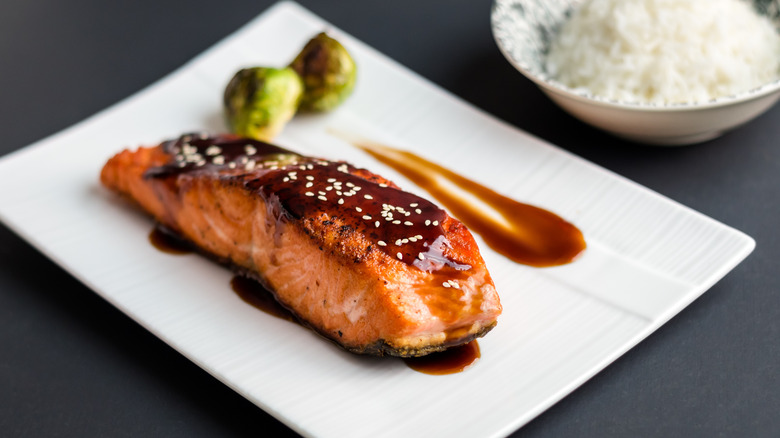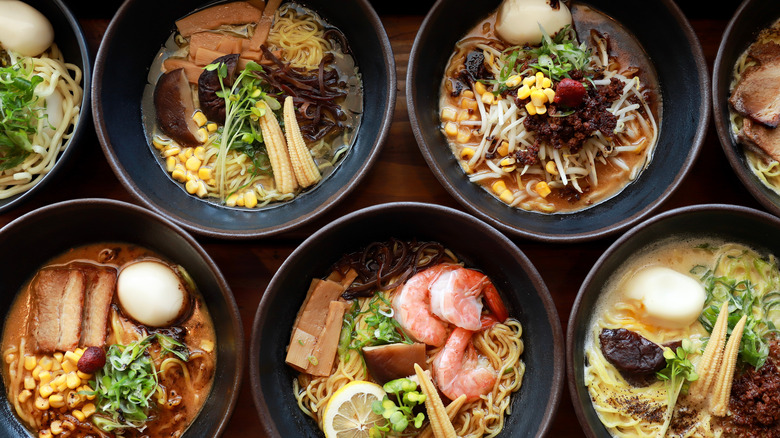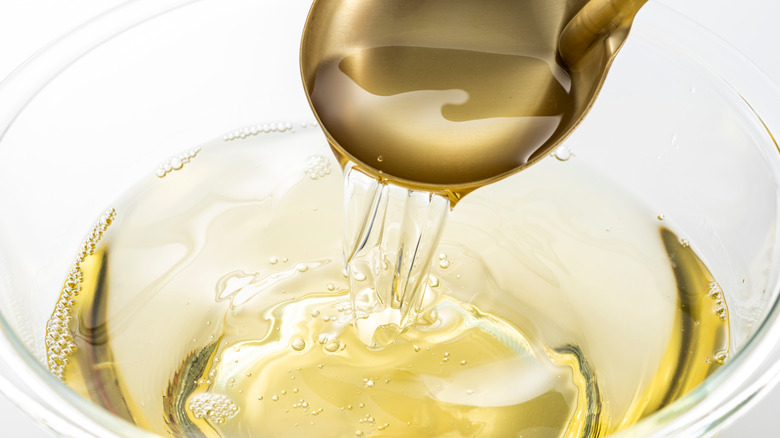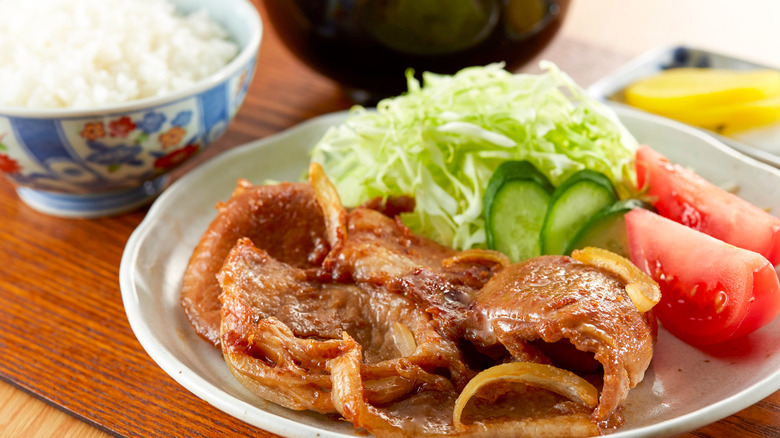What Is Mirin And What Does It Taste Like?
Even if the word mirin is unfamiliar to you, chances are you've tasted this ingredient — and liked it. Mirin is a Japanese rice wine that is a key ingredient in many beloved Asian sauces and dishes.
Mirin is sometimes compared to sake, another Japanese rice wine, but mirin is lower in alcohol and higher in sugar than the more familiar sake, and is not suitable for drinking. Unlike sake, mirin has a syrupy consistency, and ranges in color from nearly clear to deep amber. It acts as both a seasoning and a glazing agent, providing that rich, deep, and distinctive umami flavor that's present in dishes like teriyaki and your favorite ramen (via Just One Cookbook).
According to The Spruce Eats, mirin first became widely used in Japan not as a cooking ingredient, but as a luxury liquor sometime between the 15th and 17th centuries. This time was known as The Sengoku Period, which World History Encyclopedia says was marked by near-constant civil wars. However, the concoction spoiled easily because of its large amounts of yeast and sugar, so mirin was further refined into a distilled wine with the goal of prolonging its shelf life, resulting in a product similar to today's mirin. Because mirin was easier to come by than sugar at this time in Japanese history, it was used to sweeten a variety of foods.
How is mirin made?
According to The Spruce Eats, true mirin (we'll explain the difference between true mirin and lesser mirins in a moment), also called hon-mirin, is made by combining glutinous steamed rice (called mochi or mochigome), rice koji (cooked rice fermented with the mold Aspergillus oryzae, which is also present in miso), and a distilled rice liquor called shochu. Manufacturers allow the combination to ferment for two months to several years; longer aging allows the mirin to become darker and more deeply flavored (via Country Living).
According to Kikkoman, the process begins with steaming the mochi rice, which is then mixed with the rice koji and the shochu. The product then is allowed to mature and ferment in large tanks. The fermented mixture is pressed, and the extracted liquid is heated and filtered to create mirin.
Mirin's sugars are a complex carbohydrate formed naturally as a result of the fermentation process. So in true mirin, no sugar is added. According to Just One Cookbook, enzymes in the koji rice decompose the glutinous rice's starch and proteins. Saccharides, amino acids, organic acids, and fragrances are produced as the mirin ages.
Mirin's quality is affected by the quality of rice, especially the koji, as well as how long the product is aged. High-quality mirins are aged for three years, according to "The Last Artisans of Japan," a short film about the Hakusen Miren Brewing Company.
True mirin vs. other mirins
According to Japanese Food Guide, there are several types of mirin. True mirin, also known as hon-mirin, has only three ingredients: the rice, koji, and shochu mentioned above. Its natural sweetness comes from its lengthy fermentation. It has no salt and a high alcohol content (14%), according to Just One Cookbook. It is hard to find hon-mirin in U.S. grocery stores.
The other type of mirin, aji-mirin, has two varieties. Mirin-fu chomiryo (which translates to "mirin-like seasoning") is one. This is the is the most widely sold and used form of mirin in the U.S., according to Sake Times. Like hon-mirin, it's made from rice and koji, but a different chemical reaction takes place during fermentation, resulting in a product with less than 1% alcohol, driving down the cost by eliminating alcohol-related taxes. This aji-mirin gets its sweetness from sugars like corn syrup. While its flavor isn't as complex and deep as hon-mirin, Sake Times says "it's a very cost-effective way to get the job done."
Finally, there is a mirin substitute called hakko chomiryo, or fermented seasoning. The production process and alcohol content is the same as hon-mirin, but it contains about 2% salt. The salt allows it to be treated as a seasoning or a "cooking wine," which is also not subject to alcohol taxes (via Chopsticks Chronicles).
What does mirin taste like?
It is mirin that gives "a fundamental sweetness, shine, and aesthetic beauty to Japanese food," according to "The Last Artisans of Japan," a short film about the generations-old Hakusen Miren Brewing Company.
But sweetness is just the beginning when it comes to the flavor profile of mirin. This thick, rich rice wine has been described as bold and layered, and a combination of tangy and sweet (via The Spruce Eats).
In broths and marinades, mirin's sweetness complements salty ingredients like tamari or soy sauce. Mirin also adds a layer of umami richness, which makes dipping sauces, glazes, and marinades more delicious. According to The Kitchn, mirin has the ability to temper the strong flavors of fish or gamey meats. Because mirin has a strong and distinct taste, it should be used in small quantities so as not to overpower the other flavors of the dish.
Cooking with mirin
Mirin is a valuable pantry ingredient that allows you to make a variety of creations, particularly broths, sauces, and marinades for meats, fish, or vegetables. Whenever you want the combination of umami and sweet in a dish, incorporate some mirin.
Mirin's high sugar content makes it ideal for glazes and sauces. Mirin is also used as a seasoning in Japanese izakaya — small plates and snacks, similar to Spanish tapas. According to The Kitchn, a drizzle of mirin is the finishing touch for several Japanese soups, namely miso soup.
Known as a key ingredient in teriyaki as well as ponzu sauce, mirin is also used in the tempura dipping sauce ten-tsuyu (via The Spruce Eats). It is also a key component in making buta no kakuni, a braised pork belly made with mirin, soy sauce, and ginger.
You can try ceviche with mirin, make gyoza sauce with it, or whip up a flavorful beef and broccoli stir-fry. Martha Stewart even offers a Japanese Salad with Shiso Leaves, Sake, and Soba Noodles, where mirin is key in a dressing that also includes soy sauce and dried bonito flakes.
Where to buy mirin
There's a chance your local supermarket won't carry true mirin (hon-mirin), but it can be found at Asian specialty stores, as well as online, according to Just One Cookbook. Bon Appétit points out that mirin-fu chomiryo or aji-mirin products are easier to find. Look for it at the grocery store in the aisle where soy sauce and teriyaki sauce are sold. Asian specialty stores will have a broader selection of aji-mirins, but remember that unlike true mirin, these products will usually contain glucose syrup, water, alcohol, rice, corn syrup, and salt.
According to Bon Appétit, if none of these are available, you can use dry white wine or rice vinegar as a substitute. Just add a half a teaspoon of sugar for every tablespoon of these stand-ins. You could also try sherry or a sweet marsala wine in a pinch. According to Food52, sake (sweetened with a touch of fruit juice, if it's a dry variety) can also be swapped for mirin. Sweet vermouth or dry vermouth with a touch of juice or sugar can fill in for mirin as well.
Nutrition information for mirin
It should come as no surprise that food producers make more money by producing things quickly and cheaply. Adding sugar substitutes allows manufacturers to use less rice and koji and produce aji-mirins much faster.
This is why true mirin (hon-mirin) costs more. However, the lengthy fermentation process and higher quality ingredients make for a better-tasting (and better for you) mirin. The popular Takara brand of hon-mirin, for example, contains 36 calories and 6 grams of sugar per tablespoon, per Recipe of Health. Kikkoman's aji-mirin product, while nearly identical in calories, contains 90 mg of sodium according to My Fitness Pal, whereas true mirin has virtually no sodium — just 1 mg.
Hakko chomiryo has an alcohol and sugar content similar to hon-mirin (14%) because it is made the same way. However, the addition of salt (it is 2% salt) makes it exempt from alcohol taxes, and therefore cheaper to produce.
Hon-mirin contains 14% alcohol and 0% salt (via Just One Cookbook). Like cooking with wine, most of this alcohol burns off when heated. It can be stored in a cool place for up to three months. Refrigerating hon-mirin will cause its sugars to crystallize.
If you're looking for a way to add some wonderful umami flavor and natural sweetness to your cooking, keep some mirin in your pantry.
